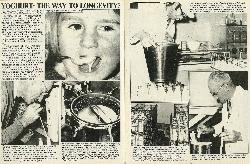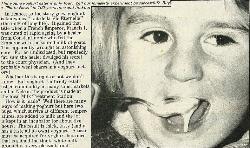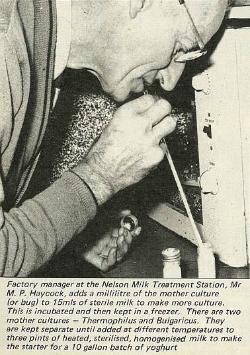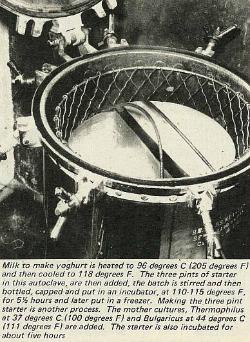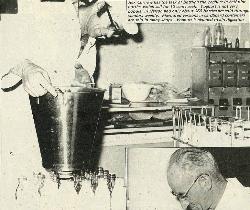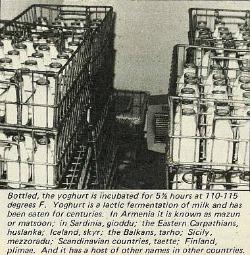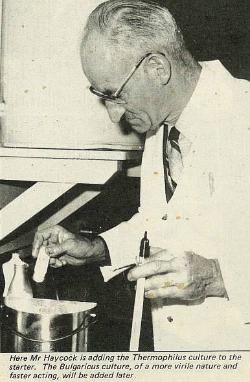30
Yoghurt: The Way to Longevity?
In France, so the story goes, yoghurt is known as "Lait de la Vie Eternelle" (the milk of long life). It gained that title when a French Emperor, Francis I, was cured of rapid ageing by a healer from Constantinople who fed the Emperor with the soured milk of goats. This apparently wrought an astonishing cure. For an undisclosed, but reputedly fat, sum the healer divulged his secret to the court physician. (And they probably went shares in a yoghurt factory).
Whether this is right or not we don't know. But yoghurt is a firmly established commodity in many supermarkets and in Nelson the product is made at the local Milk Treatment Station.
How is it made? Well there are many ways of making yoghurt but here two bugs, which survive at different temperatures, are added to milk and the lot is kept in an incubator for about five hours. The result is thick, tasty (and it has a taste all its own) yoghurt. A taste must be acquired for yoghurt but once that is gained the thick, white milk product is a very pleasant food.
This young yoghurt eater is only four. Will our longevity experiment be successful? Buy a "Photo News"in 100 years time and find out
Factory manager at the Nelson Milk Treatment Station, Mr M. P. Haycock, adds a millilitre of the mother culture (or bug) to 15mls of sterile milk to make more culture. This is incubated and then kept in a freezer. There are two mother cultures - Thermophilus and Bulgaricus. They are kept separate until added at different temperatures to three pints of heated, sterilised, homogenised milk to make the starter for a 10 gallon batch of yoghurt
Milk to make yoghurt is heated to 96 degrees C (205 degrees F) and then cooled to 118 degrees F. The three pints of starter in this autoclave, are then added, the batch is stirred and then bottled, capped and put in an incubator, at 110-115 degrees F, for 5½ hours and later put in a freezer. Making the three pint starter is another process. The mother cultures, Thermophilus at 37 degrees C (100 degrees F) and Bulgaricus at 44 degrees C (111 degrees F) are added. The starter is also incubated for about five hours
31
Rex Curnow has the task of bottling the yoghurt in half pint bottles which sell for 10 cents each. Yoghurt is not very popular in Nelson and only about 360 bottles are sold through vendors weekly. Flavoured versions in cardboard containers are sold in many shops. Yoghurt is claimed to aid digestion
Bottled, the yoghurt is incubated for 5½ hours at 110-115 degrees F. Yoghurt is a lactic fermentation of milk and has been eaten for centuries. In Armenia it is known as mazun or matsoon; in Sardinia, gioddu; the Eastern Carpathians, huslanka; Iceland, skyr; the Balkans, tarho; Sicily, mezzoradu; Scandinavian countries, taette; Finland, plimae. And it has a host of other names in other countries.
Here Mr Haycock is adding the Thermophilus culture to the starter. The Bulgaricus culture, of a more virile nature and faster acting, will be added later


